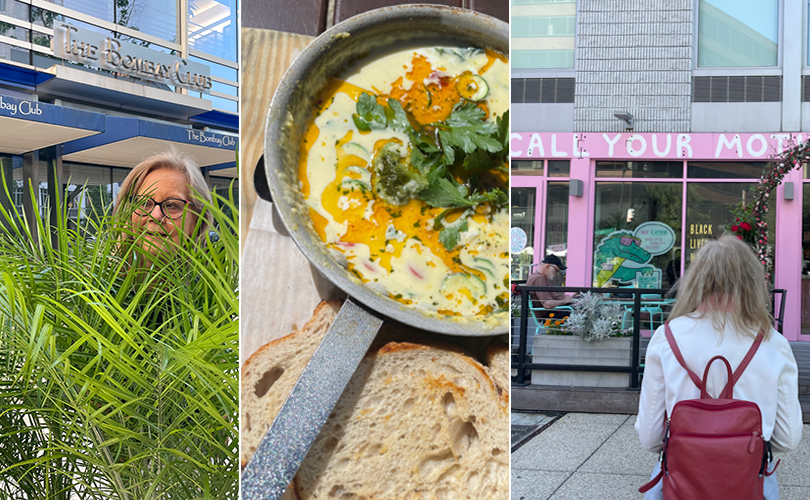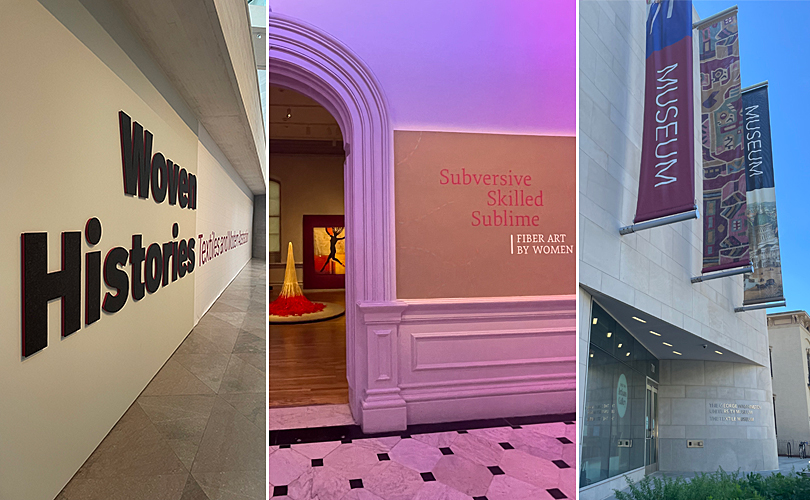
We travelled to Washington, D.C. this past weekend in search of art and archival info.

We had some delicious meals — Indian (The Bombay Club), Latin Fusion (Mercy Me), lox and bagels, (Call Your Mother) and returned to Shashuka (Tatte), a dish we first discovered in South Africa.

We did some great walking — DC is a very pedestrian-friendly town.

We scheduled the trip as a celebration of textiles. We visited three exceptional exhibitions — Subversive, Skilled, Sublime at the Renwick, Woven Histories: Textiles and Modern Abstraction at the National Gallery, Irresistible: The Global Patterns of Ikat at the George Washington University and The Textile Museum, and did some research on artists and art history at the Archives of American Art. (We’ll cover exhibition specifics in upcoming posts on arttextstyle.)

In addition to catching up with artists, curators, and friends at Sublime, we learned something interesting about the Renwick. The building was completed in 1874 and opened as DC’s first art museum, housing William Wilson Cochran’s collection of European and American art, In 1899, the building was comandeered by the Court of Claims. In the 1950s, the Court proposed demolishing the building. Happily, it was saved by First Lady, and tireless patron of the arts, Jacqueline Kennedy in 1963. President Lyndon Johnson transferred the building to the Smithsonian Institution for use as “a gallery of crafts, art, and design.” It was renovated in 1972 amd again in 2013. Between 2016 and 2023, 176,000 people have visited.

We also visited the National Gallery, East Building to see Woven Histories which has traveled from LACMA in California and which will arrive at MoMA in New York in 2025. We’ll share images and info about Woven Histories in a future post.
The National Gallery is a delight — an inspired building — widely considered I.M. Pei’s most ambitious architectural design. (Side note: David Ling, the architect behind the renovation and addition to browngrotta arts’ home/barn/gallery, worked for I.M. Pei.) The East Building houses the National Gallery’s collection of modern and contemporary art and temporary exhibitions. From the Alexander Calder sculpture in the lobby to the massive Urula von Rydingsvard wood sculpture and the striking Theaster Gates work on the 2nd floor mezzanine, to the permanent collection itself (500 works), there is much to see. Hard to pick just a few highlights but we wlll. They include: 45 Calder sculptures and paintings, a choice selection of works from the Washington Color School of the 50s and 60s, including Kenneth Noland and Alma Thomas, and an impressive collection of Mark Rothko paintings (who is a major influence for several artists who work with browngrotta arts).

Our last stop was The Textile Museum at George Washington University for Irresistible…(Watch this space in future weeks for more on that ikat exhibition.) The Museum’s collection is truly remarkable — 21,000 objects in all, Rugs and Textiles from the Islamic World, East and Southeast Asian Textiles, African Textiles, and Indigenous American Textiles. In 2016, the Museum began collecting textiles from the 20th and 21st centuries to showcase textiles as a “vibrant medium of contemporary expression.” The contemporary collection includes works by Ed Rossbach, Lia Cook, Helena Hernmarck, Cynthia Schira, James Bassler, and Polly Barton.
The Museum also houses one of the most significant textile study collections ever assembled. Nearly 4000 fragments from around the world are housed in the Cotsen Textile Traces Study Collection, compiled by philanthropist and collector, Lloyd Cotsen, who was also a patron of browngrotta arts.
One of the great things about museum hopping in DC — so many of them are free!! We just scratched the surface in the three days we were there.
The National Museum of the American Indian, National Museum of African American History and Culture and National Museum of Women in the Arts are our first stops for our next trip. (If Rhonda hadn’t been there twice already, The International Spy Museum, would be high on the list, too — it’s great fun.)
